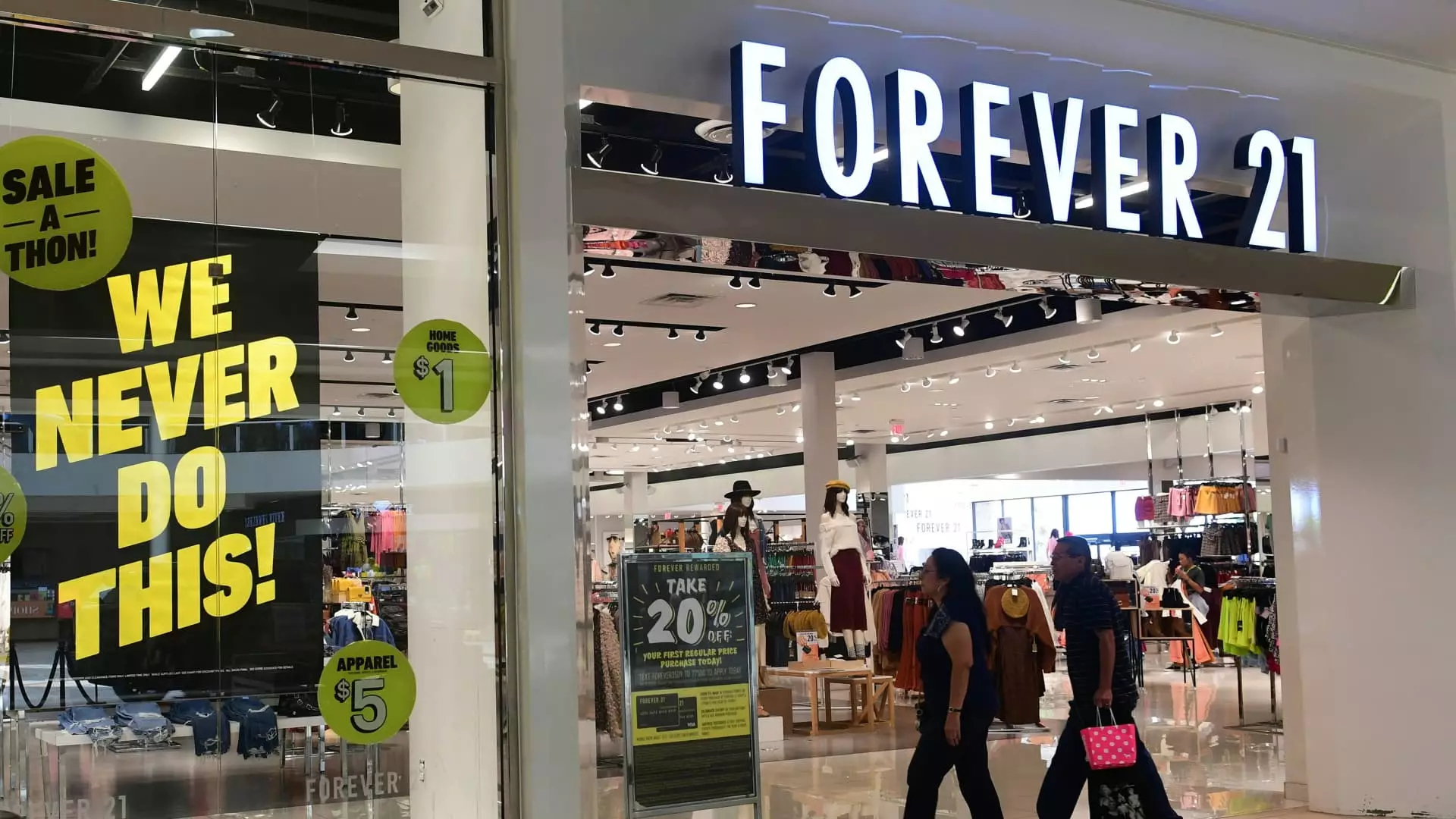In the ever-evolving landscape of fashion retail, few events encapsulate the struggle between giants and rising challengers better than the predicament faced by Forever 21. Once a prominent player in the fast fashion sector, Forever 21 now finds itself embroiled in negotiations with liquidators, signaling a period of introspection and potential upheaval. The discussions regarding liquidation indicate a desperate search for a viable path forward as the company contemplates a second bankruptcy filing after its previous chapter 11 experience in 2019. Institutions like Authentic Brands Group currently manage Forever 21’s intellectual property, but the lack of a robust operational strategy leaves the brand’s future precarious.
Details emerging from within the company shed light on the multifaceted challenges Forever 21 faces, particularly in its U.S. operations. Reports suggest that the company is grappling with not only a lack of profitability but also heightened competition from rivals like Shein and Temu—brands that have effectively utilized technology to redefine consumer engagement. As Forever 21 attempts to offload its U.S. leases and assets, the urgency of the situation is palpable; the once-beloved retailer risks fading into irrelevance. With its brand allure diminishing and operational inefficiencies becoming starkly visible, industry insiders hypothesize that finding a buyer capable of executing a turnaround is increasingly unlikely.
Competition has evolved dramatically with the rise of e-commerce platforms that leverage sophisticated algorithms to understand and respond to consumer demand. Shein and Temu, adept at using advanced metrics to track trends, have emerged as formidable adversaries, capitalizing on Forever 21’s struggles. These online-only retailers do not possess the burden of maintaining physical stores, giving them a significant edge in pricing and responsiveness to consumer trends. This shift mirrors previous disruptions in the retail sector, such as the meteoric rise of Amazon, which fundamentally reshaped consumer buying behavior and left a wake of bankruptcies in its path.
As Forever 21’s operational model lags behind, the implications of its strategic missteps become increasingly apparent; it struggles to maintain its identity amidst flashy, tech-savvy newcomers. The once-vibrant brand now grapples with a loss of relevance, as younger consumers appear less inclined to engage with its offerings.
The challenges facing Forever 21 extend beyond mere financial metrics; they encapsulate a broader cultural shift in the retail sector. Once synonymous with youth culture and trendsetting, the brand now appears dated alongside its competitors, raising concerns about its ability to attract a loyal customer base. The partnership with Shein reveals the complexity of these dynamics, as observers note the inconsistencies in their collaboration. While the partnership has potential, transforming it into a successful retail strategy remains an elusive goal.
As Forever 21 seeks ways to stabilize its operations, it is reportedly exploring new avenues to rejuvenate its brand. However, the challenge lies in its capacity to pivot successfully without sacrificing its identity or alienating existing customers. How could Forever 21 revitalize its allure in a market dominated by brands that have effectively captured consumer aspirations?
The possibility of liquidation looms larger as discussions about the future continue. If Forever 21 chooses to move in that direction, the ramifications would extend beyond its own struggles, representing a significant loss in the fast fashion sector. Brands such as Forever 21, which once thrived on rapid turnover, face existential threats in an era defined by the necessity for agility and innovation. Authentic Brands Group’s role becomes particularly crucial; having acquired Forever 21’s intellectual property, it may ultimately attempt to revive the name, albeit in a radically different form from the original.
Rumors abound regarding the potential acquisition of Forever 21’s assets, but genuine interest from buyers appears muted. The growing dominance of brand management firms that specialize in acquiring intellectual property leaves questions on who, if anyone, would step up to invest in the beleaguered retailer. The industry anticipates that seasoned brands may emerge as saviors of such intellectual properties, strategically repositioning them in the broader marketplace.
Ultimately, the saga surrounding Forever 21 serves as a reflective moment for the broader retail industry, illustrating the necessity for adaptability in a rapidly changing consumer environment. The rise of competitors like Shein and Temu signifies more than just shifting market dynamics; it underscores the importance of innovation and understanding consumer needs in real-time. As the dust settles around Forever 21’s fate, one key lesson emerges: without a willingness to evolve, even industry titans can swiftly find themselves on the brink of extinction. The future of retail will undoubtedly be shaped by how well companies can pivot, innovate, and resonate with their target audiences. Forever 21 stands at a crossroads, and its next steps will not only define its own path but could also serve as a cautionary tale for others in the industry.

